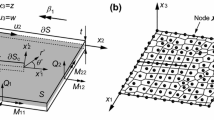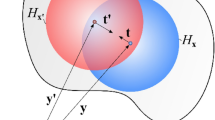Abstract
In this paper, a new effective method named state-space is extended and utilized to analyze FGM dynamic fracture problems, discretized by the meshless local Petrov–Galerkin method. Both the moving least square and the direct method have been applied to estimate the shape function and to impose the essential boundary conditions. The visibility criterion is used to simulate the displacement and stress field around the crack tip. Normalized dynamic stress intensity factors are calculated using the path-independent integral, J*, which is formulated for the non-homogeneous material. Two methods commonly used in solving such discretized problems, namely, the central difference method and the Newmark method, are compared with the proposed method. Both homogeneous and non-homogeneous (FGM) center-cracked plates under uniform tensile impact load are used to examine the accuracy and the computational time of the new method. The results of the implementation of these methods are compared with existent solutions. The results show that the state-space method saves substantial computational time for a given accuracy. The center-cracked plate made of FGM with two different material gradations (along and normal to the crack length) and four different FGM zones under the effect of uniform tensile impact load are considered, and the dynamic stress intensity factors are studied under the influence of various non-homogeneity ratios.











Similar content being viewed by others
References
Abdollahifar A, Nami MR (2014) Determination of dynamic stress intensity factors in FGM plates by MLPG method. IJST Trans Mech Eng 38:181–194
Abdollahifar A, Shafiei AR, Mohyeddin A, Bozorg M (2010) Using state-space models for solving elastodynamic problems discretized by the MLPG method. Eng Anal Bound Elem 34(8):721–726
Abdollahifar A, Nami MR, Shafiei AR (2012) A new MLPG method for elastostatic problems. Eng Anal Bound Elem 36:451–457
Abdollahifar A, Nami MR, Saranjam B (2014) Mixed-mode dynamic fracture analysis of FGM plate by MFree method. J Appl Comput Sci Mech 25(2):1–18
Aberson JA, Anderson JM, King WW (1977) Dynamic analysis of cracked structures using singularity finite elements. In: Sih GC (ed) Mechanics of fracture, vol 4. Noordhoff International Publishing, Leyden, pp 249–294
Albuquerque EL, Sollero P, Fedelinski P (2003) Dual reciprocity boundary element method in Laplace domain applied to anisotropic dynamic crack problems. Comput Struct 81:1703–1713
Andreaus U, Batra R, Porfiri M (2005) Vibrations of cracked Euler–Bernoulli beams using meshless local Petrov-Galerkin (MLPG) method. Comput Model Eng Sci (CMES) 9(2):111–131
Atluri SN, Shen SP (2002) The meshless local Petrov-Galerkin (MLPG) method. Tech Sci P
Atluri SN, Zhu TL (1998) A new meshless local Petrov-Galerkin (MLPG) approach in computational mechanics. Comput Mech 22:117–127
Atluri SN, Sladek J, Sladek V, Zhu T (2000) The local boundary integral equation (LBIE) and its meshless implementation for linear elasticity. Comput Mech 25:180–198
Baker BR (1962) Dynamic stresses created by a moving crack. J Appl Mech 29:449–545
Belytschko T, Lu YY, Gu L (1994) Element-free Galerkin methods. Int J Numer Methods Eng 37:229–256
Brogan WL (1991) Modern control theory, 3rd edn. Prentice-Hall, Inc., Upper Saddle River
Chalivendra VB (2008) Mode-I crack-tip stress fields for inhomogeneous orthotropic medium. Mech Mater 40:293–301
Ching HK, Batra RC (2001) Determination of crack tip fields in linear elastostatics by the meshless local Petrov-Galerkin (MLPG) method. CMES 2(2):273–289
Ching HK, Yen SC (2005) meshless local Petrov-Galerkin analysis for 2D functionally graded elastic solids under mechanical and thermal loads. Compos Part B 36:223–240
Delale F, Erdogan F (1983) The crack problem for a non-homogeneous plan. J Appl Mech 50:609–614
Eischen JW (1987) Fracture of nonhomogeneous materials. Int J Fract 34:3
Fedelinski P, Aliabadi MH, Rooke DP (1994) The dual boundary method: J-integral for dynamic stress intensity factors. Int J Fract 65:369–381
Fleming M, Chu Y, Moran B, Belytschko T (1997) Enriched element-free Galerkin methods for crack tip fields. Int J Numer Methods Eng 40:1483–1504
Gu P, Dao M, Asaro RJ (1999) A simplified method for calculating the crack tip field of functionally graded materials using the domain integral. J Appl Mech 66:101–108
Krysl P, Belytschko T (1997) Element-free Galerkin: convergence of the continuous and discontinuous shape functions. CMES 148:257–277
Liu GR, Gu YT (2005) An introduction to meshfree methods and their programming. Springer, Netherlands
Lucy L (1977) A numerical approach to testing the fission hypothesis. Astron J 82:1013–1024
Marur PR, Tippur HHV (2000) Numerical analysis of crack-tip fields in functionally graded materials with a crack normal to the elastic gradient. Int J Solids Struct 37:5353–5370
Nami MR, Eskandari H (2012) Three-dimensional investigation of stress intensity factor in cracked cylinder made of functionally graded materials. Mech Based Des Struct Mach 40:206–217
Newmark NM (1959) A method of computation for structural dynamics. J Eng Mech Div Proc ASCE 85(3):67–94
Nishioka T, Atluri SN (1980) Numerical modeling of dynamic crack propagation in finite bodies by moving singular elements, part II. J Appl Mech 47:577–582
Organ DJ, Fleming M, Belytschko T (1996) Continuous meshless approximations for nonconvex bodies by diffraction and transparency. Comput Mech 18:225–235
Schwartz M (2002) Encyclopedia of smart material. Wiley, Hoboken
Shanmugavel P, Bhaskar GB, Chandrasekaran M, Mani PS, Srinivasan SP (2012) An overview of fracture analysis in functionally graded materials. Eur J Sci Res 68(3):412–439
Shbeeb NI, Binienda WK (1999) Analysis of an interface crack for a functionally graded plate sandwiched between two homogeneous layers of finite thickness. Eng Fract Mech 64:693–720
Shiota I, Miyamoto Y (1997) Functionally graded materials 1996. Elsevier, Amsterdam
Shukla A (2006) Dynamic fracture mechanics. World Scientific Publishing Co., Singapore
Sladek J, Sladek V, Atluri SN (2000) Local boundary integral equation (LBIE) method for solving problems of elasticity with nonhomogeneous material properties. Comput Mech 24:456–462
Tohgo K, Sakaguchi M, Ishii H (1996) Applicability of fracture mechanics in strength evaluation of functionally graded materials. JSME Inter J Ser I 39(4):479–488
Author information
Authors and Affiliations
Corresponding author
Rights and permissions
About this article
Cite this article
Abdollahifar, A., Sabet, B. & Nami, M.R. Transient Dynamic Stress Intensity Factor of FGM Plates Using the State Space and MLPG Methods. Iran J Sci Technol Trans Mech Eng 43 (Suppl 1), 733–748 (2019). https://doi.org/10.1007/s40997-018-0191-8
Received:
Accepted:
Published:
Issue Date:
DOI: https://doi.org/10.1007/s40997-018-0191-8




